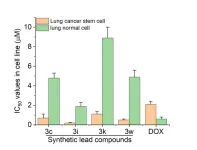(Press-News.org)
Of the many different kinds of stars, asymptotic giant branch (AGB) stars, usually slightly larger and older than our own sun, are known producers of interstellar dust. Dusty AGBs are particularly prominent producers of dust, and the light they shine happens to vary widely. For the first time, a long-period survey has found the variable intensity of dusty AGBs coincides with variations in the amount of dust these stars produce. As this dust can lead to the creation of planets, its study can shed light on our own origins.
You’ve probably heard of the James Webb Space Telescope (JWST) which has been in the news lately. It’s famous for being the largest and most sensitive space telescope designed to observe infrared (IR) light. But long before the JWST took to the skies, two other IR space telescopes, AKARI and WISE, have been surveying the cosmos, both of which have ended their initial missions, but produced so much valuable data that astronomers are still finding new discoveries with it. The latest finding from that data by doctoral student Kengo Tachibana from the University of Tokyo’s Institute of Astronomy and his team, could have implications for the study of the origins of life itself.
“We study stars, and IR light from them is a key source of information that helps us unlock their secrets,” said Tachibana. “Until recently, most IR data was from very short-period surveys due to the lack of advanced dedicated platforms. But missions like AKARI and WISE have allowed us to take longer-period surveys of things. This means we can see how things might change over greater time periods, and what these changes might imply. Lately, we turned our attention to a certain class of star known as asymptotic giant branch stars, which are interesting because they are the main producers of interstellar dust.”
This interstellar dust is not the same stuff that accumulates on your floor when you forget to vacuum for a few days; it’s a name given to heavy elements that disperse from stars and lead to the formation of solid objects including planets. Although it’s long been known that AGBs, and especially so-called dusty AGBs, are the main producers of dust, it’s not known what the main drivers of dust production are and where we should be looking to find this out.
“Our latest study has pointed us in the right direction,” said Tachibana. “Thanks to long-period IR observations, we have found that the light from dusty AGBs varies with periods longer than several hundred days. We also found that the spherical shells of dust produced by and then ejected by these stars have concentrations of dust that vary in step with the stars’ changes in luminosity. Of the 169 dusty AGBs surveyed, no matter their variability period, the concentrations of dust around them would coincide. So, we’re certain these are connected.”
Finding a connection between the concentration of dust and the variability of stars’ brightness is just the first step in this investigation however. Now the team wishes to explore the possible physical mechanisms behind the production of dust. For this, they intend to monitor various AGB stars for many years continuously. The University of Tokyo is nearing completion of a large ground-based telescope project, the University of Tokyo Atacama Observatory, in Chile, which will be dedicated to making infrared observations.
###
Journal article
Kengo TACHIBANA, Takashi MIYATA, Takafumi KAMIZUKA, Ryou OHSAWA, Satoshi TAKITA, Akiharu NAKAGAWA, Yoshifusa ITA and Mizuho UCHIYAMA, “Investigation of mid-infrared long-term variability of dusty AGB stars using multiepoch scan data of AKARI and WISE”, Publications of the Astronomical Society of Japan, DOI
Funding
This work was supported by JST SPRING, Grant Number JPMJSP2108.
Useful links
Graduate School of Science - https://www.s.u-tokyo.ac.jp/en/
Institute of Astronomy - http://www.ioa.s.u-tokyo.ac.jp/en/
Research contacts
Kengo Tachibana - kengo-tachibana@ioa.s.u-tokyo.ac.jp
Institute of Astronomy, The University of Tokyo,
2-21-1 Osawa, Mitaka, Tokyo 181-0015, JAPAN
Press Contact
Mr. Rohan Mehra - press-releases.adm@gs.mail.u-tokyo.ac.jp
Division for Strategic Public Relations, The University of Tokyo
7-3-1 Hongo, Bunkyo-ku, Tokyo 113-8654, JAPAN
About the University of Tokyo
The University of Tokyo is Japan's leading university and one of the world's top research universities. The vast research output of some 6,000 researchers is published in the world's top journals across the arts and sciences. Our vibrant student body of around 15,000 undergraduate and 15,000 graduate students includes over 4,000 international students. Find out more at www.u-tokyo.ac.jp/en/ or follow us on Twitter at @UTokyo_News_en.
END
Extreme water events have been shown to affect human security in many ways. In a research article published today in the new journal Nature Water researchers from Politecnico di Milano and University of California at Berkeley delve deeper into the complex nexus between droughts and conflicts in Central America. For the decades from 1996 to 2016 explore how water availability affects agricultural production and food security, and investigate the nexus between drought-induced food insecurity and the emergence of conflict in the region. Cities in ...
A fasting diet which focuses on eating early in the day could be the key to reducing the risk of developing type 2 diabetes.
Researchers from the University of Adelaide and South Australian Health and Medical Research Institute (SAHMRI) compared two different diets: a time restricted, intermittent fasting diet and a reduced calorie diet to see which one was more beneficial for people who were prone to developing type 2 diabetes.
“Following a time restricted, intermittent fasting diet could help lower the chances of developing type 2 diabetes,” said ...
COLUMBUS, Ohio – A new machine learning model that estimates optimal treatment timing for sepsis could pave the way for support tools that help physicians personalize treatment decisions at the patient bedside, researchers say.
In a paper published today (April 6, 2023) in Nature Machine Intelligence, scientists from The Ohio State University describe the new model, which uses artificial intelligence to take on the complex question of when to administer antibiotics to patients with a suspected case of sepsis.
Time is of the essence ...
Researchers Ludovico Lami (QuSoft, University of Amsterdam) and Mark M. Wilde (Cornell) have made significant progress in quantum computing by deriving a formula that predicts the effects of environmental noise. This is crucial for designing and building quantum computers capable of working in our imperfect world.
The choreography of quantum computing
Quantum computing uses the principles of quantum mechanics to perform calculations. Unlike classical computers, which use bits that can be either 0 or 1, quantum computers use quantum bits, or qubits, which can be in a superposition of 0 and 1 simultaneously.
This ...
An analysis of strands of human hair from a burial site in Menorca, Spain, indicates that ancient human civilisations used hallucinogenic drugs derived from plants, reports a new paper published in Scientific Reports. These findings are the first direct evidence of ancient drug use in Europe, which may have been used as part of ritualistic ceremonies.
Previous evidence of prehistoric drug use in Europe has been based on indirect evidence such as the detection of opium alkaloids in Bronze Age containers, the ...
Analysing changes to DNA in the blood can improve the ability to predict a person’s risk of developing type 2 diabetes within a decade.
Scientists looked at the influence of these changes – known as DNA methylation – alongside other risk factors in almost 15,000 people to predict the likelihood of developing the condition years in advance of any symptoms developing.
The findings could lead to preventative measures being put in place earlier, reducing the economic and health burden caused by type 2 diabetes.
Methylation is a chemical process in the body in which a small molecule called a methyl group is added to DNA.
Current ...
JOHANNESBURG, SOUTH AFRICA and SHENZHEN, CHINA - 31.03.23
Akili Labs (Pty) Ltd, a pioneer of cost-effective molecular diagnostics and secure genomic data storage solutions, and BGI Genomics Co. Ltd, the world’s leading integrated solutions provider of precision medicine, today announced the signing of a technology transfer agreement that will provide the Southern region of Africa with clinical-grade sequencing solutions.
"Improving the cost and turnaround time of genetic sequencing services will play a major role in the expansion of precision medicine-driven healthcare in Africa," said Charles F.J. Faul, co-founder ...
WASHINGTON — Researchers have developed a new way to create dynamic ultrahigh-density 3D holographic projections. By packing more details into a 3D image, this type of hologram could enable realistic representations of the world around us for use in virtual reality and other applications.
“A 3D hologram can present real 3D scenes with continuous and fine features,” said Lei Gong, who led a research team from the University of Science and Technology of China. “For virtual reality, our method could be used with headset-based holographic displays to greatly improve the viewing angles, which would enhance the 3D viewing experience. ...
A research team co-led by chemists from City University of Hong Kong (CityU) recently discovered novel, highly effective anticancer agents with tridimensional structures, which have high anticancer activity, low toxicity and the ability to overcome drug resistance in cancer cells. The findings help provide a new direction for anticancer drug development.
Cancer has long been a devastating disease, which affects millions of people worldwide. Despite advances in treatment, current anticancer drugs often have limited effectiveness, lack of cancer ...
The American Society for Biochemistry and Molecular Biology sent recommendations March 30 to the National Institute of Allergy and Infectious Diseases on expanding the institute’s diversity, equity, accessibility and inclusivity activities.
The society recommended, broadly, that the NIAID expand the use of diversity and re-entry grant supplements and better support disabled, LGBTQ+ and other underrepresented scientists.
“Because NIAID is one of the largest NIH institutes, they have ...





